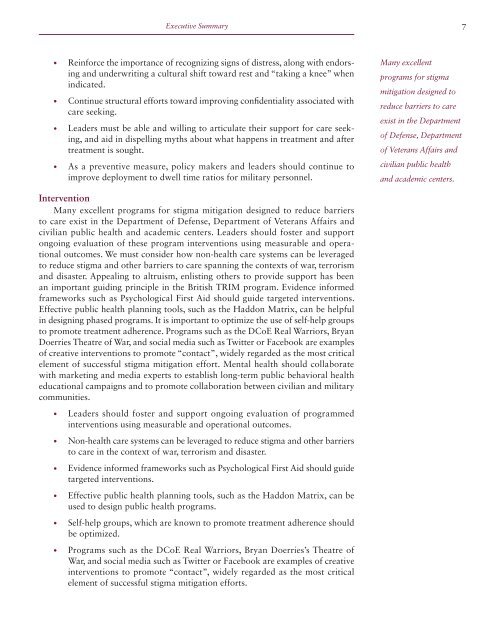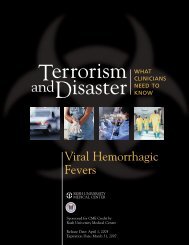stigma and barriers to care - Uniformed Services University of the ...
stigma and barriers to care - Uniformed Services University of the ...
stigma and barriers to care - Uniformed Services University of the ...
Create successful ePaper yourself
Turn your PDF publications into a flip-book with our unique Google optimized e-Paper software.
Executive Summary 7<br />
••<br />
Reinforce <strong>the</strong> importance <strong>of</strong> recognizing signs <strong>of</strong> distress, along with endorsing<br />
<strong>and</strong> underwriting a cultural shift <strong>to</strong>ward rest <strong>and</strong> “taking a knee” when<br />
indicated.<br />
••<br />
Continue structural efforts <strong>to</strong>ward improving confidentiality associated with<br />
<strong>care</strong> seeking.<br />
••<br />
Leaders must be able <strong>and</strong> willing <strong>to</strong> articulate <strong>the</strong>ir support for <strong>care</strong> seeking,<br />
<strong>and</strong> aid in dispelling myths about what happens in treatment <strong>and</strong> after<br />
treatment is sought.<br />
••<br />
As a preventive measure, policy makers <strong>and</strong> leaders should continue <strong>to</strong><br />
improve deployment <strong>to</strong> dwell time ratios for military personnel.<br />
Many excellent<br />
programs for <strong>stigma</strong><br />
mitigation designed <strong>to</strong><br />
reduce <strong>barriers</strong> <strong>to</strong> <strong>care</strong><br />
exist in <strong>the</strong> Department<br />
<strong>of</strong> Defense, Department<br />
<strong>of</strong> Veterans Affairs <strong>and</strong><br />
civilian public health<br />
<strong>and</strong> academic centers.<br />
Intervention<br />
Many excellent programs for <strong>stigma</strong> mitigation designed <strong>to</strong> reduce <strong>barriers</strong><br />
<strong>to</strong> <strong>care</strong> exist in <strong>the</strong> Department <strong>of</strong> Defense, Department <strong>of</strong> Veterans Affairs <strong>and</strong><br />
civilian public health <strong>and</strong> academic centers. Leaders should foster <strong>and</strong> support<br />
ongoing evaluation <strong>of</strong> <strong>the</strong>se program interventions using measurable <strong>and</strong> operational<br />
outcomes. We must consider how non-health <strong>care</strong> systems can be leveraged<br />
<strong>to</strong> reduce <strong>stigma</strong> <strong>and</strong> o<strong>the</strong>r <strong>barriers</strong> <strong>to</strong> <strong>care</strong> spanning <strong>the</strong> contexts <strong>of</strong> war, terrorism<br />
<strong>and</strong> disaster. Appealing <strong>to</strong> altruism, enlisting o<strong>the</strong>rs <strong>to</strong> provide support has been<br />
an important guiding principle in <strong>the</strong> British TRIM program. Evidence informed<br />
frameworks such as Psychological First Aid should guide targeted interventions.<br />
Effective public health planning <strong>to</strong>ols, such as <strong>the</strong> Haddon Matrix, can be helpful<br />
in designing phased programs. It is important <strong>to</strong> optimize <strong>the</strong> use <strong>of</strong> self-help groups<br />
<strong>to</strong> promote treatment adherence. Programs such as <strong>the</strong> DCoE Real Warriors, Bryan<br />
Doerries Theatre <strong>of</strong> War, <strong>and</strong> social media such as Twitter or Facebook are examples<br />
<strong>of</strong> creative interventions <strong>to</strong> promote “contact”, widely regarded as <strong>the</strong> most critical<br />
element <strong>of</strong> successful <strong>stigma</strong> mitigation effort. Mental health should collaborate<br />
with marketing <strong>and</strong> media experts <strong>to</strong> establish long-term public behavioral health<br />
educational campaigns <strong>and</strong> <strong>to</strong> promote collaboration between civilian <strong>and</strong> military<br />
communities.<br />
••<br />
Leaders should foster <strong>and</strong> support ongoing evaluation <strong>of</strong> programmed<br />
interventions using measurable <strong>and</strong> operational outcomes.<br />
••<br />
Non-health <strong>care</strong> systems can be leveraged <strong>to</strong> reduce <strong>stigma</strong> <strong>and</strong> o<strong>the</strong>r <strong>barriers</strong><br />
<strong>to</strong> <strong>care</strong> in <strong>the</strong> context <strong>of</strong> war, terrorism <strong>and</strong> disaster.<br />
••<br />
Evidence informed frameworks such as Psychological First Aid should guide<br />
targeted interventions.<br />
••<br />
Effective public health planning <strong>to</strong>ols, such as <strong>the</strong> Haddon Matrix, can be<br />
used <strong>to</strong> design public health programs.<br />
••<br />
Self-help groups, which are known <strong>to</strong> promote treatment adherence should<br />
be optimized.<br />
••<br />
Programs such as <strong>the</strong> DCoE Real Warriors, Bryan Doerries’s Theatre <strong>of</strong><br />
War, <strong>and</strong> social media such as Twitter or Facebook are examples <strong>of</strong> creative<br />
interventions <strong>to</strong> promote “contact”, widely regarded as <strong>the</strong> most critical<br />
element <strong>of</strong> successful <strong>stigma</strong> mitigation efforts.




